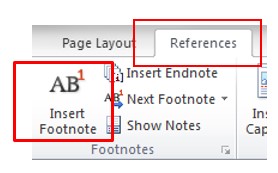AGLC referencing
General rules for footnotes
Footnotes are used to:
- Acknowledge sources of information you have used in your assignments, and
- Provide information that enables the reader to find the sources that you used
The footnote number should appear directly after the full stop in the text of your assignment (however a footnote number may appear directly after the relevant text if it is necessary for the sake of clarity, see rule 1.1.2).
Any direct quotes in your assignment must be immediately followed by a footnote (unless their source has been provided in full in the text, see rule 1.1.1). You must also always include a footnote when you have paraphrased from a source.
You must put a full stop at the end of each footnote.
If you wish to cite a second reference in the same footnote, type a semicolon and space (see rule 1.1.3 for exceptions to this rule). For example:
1 Wong v Commonwealth (2000) 236 CLR 573, 200; Crimes Act 1958 (Vic) s 3.
Repeated footnotes
If a source immediately following a footnote is the same then you can use ‘ibid’ (meaning ‘the same’). If the pinpoint reference is different then you can use ‘ibid’ and the new pinpoint with no comma in between, e.g. Ibid 65-67.
If a source has been referred to in an earlier footnote but is not the same as the one directly above it then you can use the author’s surname and a cross reference in brackets to refer to that previous citation, e.g. Jones (n 3). For cases and legislation you can use the short title or popular name rather than the author’s name, e.g. Tasmanian Dam Case (n 12). The short title should follow rule 1.4.4.
Examples of using ibid and (n):
1 Eric Berendt, Freedom of Speech (Oxford University Press, 2nd ed, 2005) 163.
2 Ibid.
3 Ibid 174-5.
4 Catherine Macmillan, Mistakes in Contract Law (Hart Publishing, 2010) 38.
5 Administrative Decisions (Judicial Review) Act 1977 (Cth) s 37 (‘ADJR Act’).
6 MacMillan (n 4).
7 ADJR Act (n 5).
Discursive text in footnotes
Footnotes may contain text which is not a citation. Citations relating to discursive text in footnotes should appear after a colon at the end of the text (unless the full citation appears within the discursive text, including relevant pinpoints), e.g.
8 The scope of this legislation is confined to children as users of the internet: Enhancing Online Safety Act 2015 (Cth) s 5.
Inserting footnotes in Word
To add footnotes to your Word document:
- Position your cursor at the appropriate place in your Word document
- Click on the References tab
- Click on Insert Footnote
- Type in the reference for the source following the guidelines

Pinpoint citations
A pinpoint is a reference to a specific page or paragraph. A pinpoint to a page should appear as a number. A pinpoint to a paragraph should appear as a number in square brackets. It is placed at the end of the reference and for most resource types it should be preceded by a space. For example:
HLA Hart, The concept of Law (Clarendon Press, 1970) 15.
For some resource types such as journal articles and cases you are required to place a comma before the pinpoint. For example:
Gordon Goldberg, ‘Confusions Concerning Common Count’ [2000] Restitution Law Review 189, 67.
Common resource types which require a comma before the pinpoint:
- Cases
- Journal articles
- Chapter in an edited book
- Gazettes
- Parliamentary debates
- Written correspondence
Always check the examples provided for your resource type to see if a comma is required or not.
Quotations within the text
Short quotations (of three lines or less) should be incorporated within single quotation marks. For example:
Priestley JA stated that ‘there is a close association of ideas between the terms unreasonableness, lack of good faith and unconscionability.’12
Long quotations (of four lines or more) should appear indented from the left margin, in a smaller font size and without quotation marks. Legislative and treaty extracts, regardless of length may also appear this way. For example:
The Judge stated:
Thus elaborating, the first question is whether a financial benefit is given within the meaning of s 229 of the Corporations Act (in relation to the prohibition on related party benefits without member approval). The second question is whether the exception for arm’s length terms in s 210 of the Corporations Act is made out…23
Omissions, alterations and significant errors in quotes:
- Omissions from a quotation should be indicated by an ellipsis (…).
- If you need to alter a quotation in any way include the alteration in square brackets.
- If there is a significant error in the quotation you may use [sic].
Citing quoted material
AGLC prefers you to cite the original text if it is available. If this is not possible, then you should give as full a reference to the original text as you can and use the words ‘quoted in’ or ‘cited in’ or ‘discussed in’ and give a full reference to the secondary text. For example:
Mason v Freedman [1958] SCR 483, quoted in Shelanu Inc v Print Three Franchising Corporation (2003) 64 OR (3d) 533, 556.